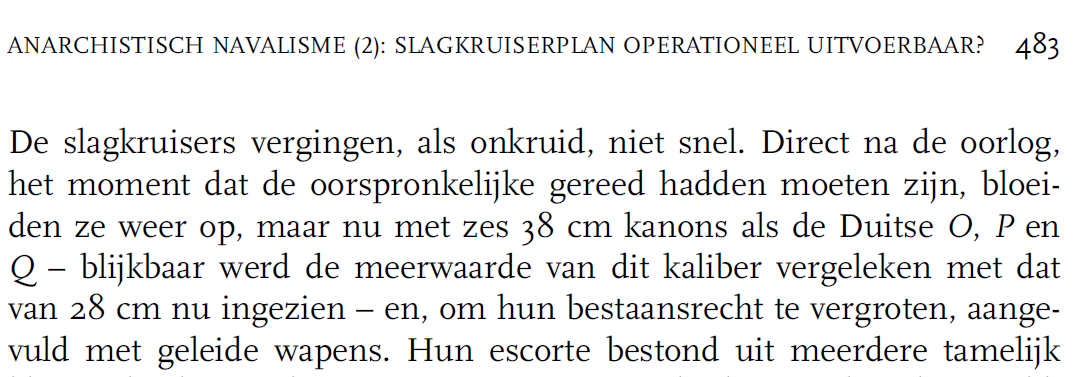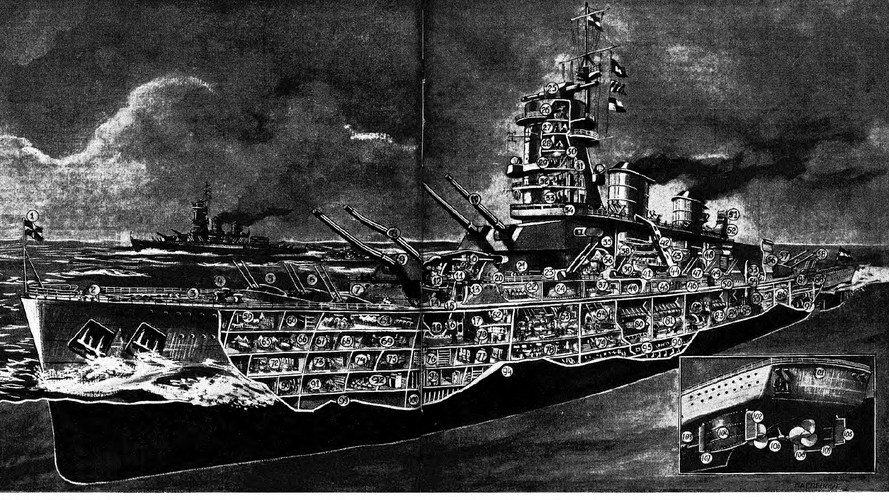Sanglune
ACCESS: Restricted
- Joined
- 2 December 2020
- Messages
- 9
- Reaction score
- 58
A period ago I found in J. Anten's 'Navalisme Nekt Onderzeeboot' mention of a postwar Dutch Battlecruiser; armed with 38 cms cannons. Now that I look at it again it also mentions guided weapons which I seem to have forgotten because it didn't seem tangible.
But as of yesterday evening, I came across a better rendition of the project. In 'Schip en Werf' of 1946, issue No. 10 dated 17th of May a single page is dedicated to this vessel. It contains an artistic cutaway rendition and a short passage of text. The image was titled 'Model van Slagschip voor de Koninklijke Marine' - tl: model of a Battleship of the RNN.
There's also a short description affixed underneath the page.
I'll provide the original text and translation:
TL:
OT:
But as of yesterday evening, I came across a better rendition of the project. In 'Schip en Werf' of 1946, issue No. 10 dated 17th of May a single page is dedicated to this vessel. It contains an artistic cutaway rendition and a short passage of text. The image was titled 'Model van Slagschip voor de Koninklijke Marine' - tl: model of a Battleship of the RNN.
There's also a short description affixed underneath the page.
I'll provide the original text and translation:
TL:
Now that the airweapon provides speed, is this factor no longer needed for battleships. Thus the ship can be shorter, needs less machinery weight and required boilers and less length to armour. The armour isn't very thick because current heavy projectiles penetrate everything anyway. But to ward against light projectiles and to localise explosions a lot of light armour has been applied. The rocketbomb guided by radio is new. The machinery is in an unorthodox position, namely high up, to protect them against mines and torpedos. Consequently the screws can't be driven directly, but are driven by electric motors. In the machinery room are dynamos to provide the necessary power.
The ship is expected to be for the indies in a "United Nations" fleet. Hence the main battery is conservative. The ship is foremost a vessel to transport the main battery. For aircraft and torpedos are other ships in mind. The mediumcalibre 12cm AA guns are chosen for their ability to work against destroyers and motortorpedoboats.
Information: 33.000 ton, 28.400 ton washington.
L,B,H,D, 216m/30m/13,60m/8,80m
66.000 SHP, 25 kts.
6 - 38cm, 32 - 12cm, 36 - 2cm, 1 guided rocket tower.
Author's note: I will not go over all the numbers, most of them are basic stuff.
The 12cms are described as sunken turrets.
52 protected radioservice fort the missiles. (2 pieces)
53 radio guided rocket-bomb
94 armoured belt 300 mm
98 mine-deck (30 mm armour)
102 rudder
104 keg (protection for screws against torpedoes)
107 forward rudder (smaller than aft rudder)
The ship is expected to be for the indies in a "United Nations" fleet. Hence the main battery is conservative. The ship is foremost a vessel to transport the main battery. For aircraft and torpedos are other ships in mind. The mediumcalibre 12cm AA guns are chosen for their ability to work against destroyers and motortorpedoboats.
Information: 33.000 ton, 28.400 ton washington.
L,B,H,D, 216m/30m/13,60m/8,80m
66.000 SHP, 25 kts.
6 - 38cm, 32 - 12cm, 36 - 2cm, 1 guided rocket tower.
Author's note: I will not go over all the numbers, most of them are basic stuff.
The 12cms are described as sunken turrets.
52 protected radioservice fort the missiles. (2 pieces)
53 radio guided rocket-bomb
94 armoured belt 300 mm
98 mine-deck (30 mm armour)
102 rudder
104 keg (protection for screws against torpedoes)
107 forward rudder (smaller than aft rudder)
OT:
Nu het vliegwapen voor snelheid zorgt, is deze factor voor slagschepen geen vereiste meer. Dus kan het schip korter zijn, heeft minder machinegewicht en benodigde ketels en minder te pantseren lengte. De pantsering is niet enorm dik, omdat huidige zwaren projectielen toch door alles heendringen. Maar tegen lichte projectielen en om ontploffingen te localiseren is er zeer veel licht pantser aangegeven. De toepassing van raketbommen door radio bestuurd is nieuw. De machines staan op een ongewone plaats, namelijk zeer hoog, om ze zo goed mogelijk tegen grondmijnen en torpedo's te beschermen. Als gevolg daarvan kunnen de lager liggende schroefassen niet rechtstreeks door de machines worden gedreven doch geschiedt dit door electromotoren. In de machinekamers staan door de turbine aangedreven dynamo's, welke de benodigde stroom leveren.
Het schip is gedacht voor Indië bestemd te zijn, in het kader van een "United Nations" vloot. Daarom is de batterij bescheiden gehouden. Het schip is in de eerste plaats een middel om de batterij te vervoeren; voor vliegtuigen, torpedo's enz. zijn andere schepen gedacht. Het tussenkaliber 12cm anti-luchtvaartgeschut is gekozen om eveneens tegen torpedobootjagers, torpedomotorboten enz. te kunnen ageren.
Afmetingen en bewapening: 33.000 ton (28.400 Wash.) L. waterlijn 216 m. B. 30 m. H. 13,60 m. Diepg. 8,80 m. Machineverm. 66.000 aspk. Snelheid 25 mijl. 6 kan. 38 cm, 32 kan. 12 cm, 36-2 cm A.L. 1 Radio-rakettoren.
Author's note: I will not go over all the numbers, most of them are basic stuff.
The 12cms are described as verzonken torens.
52 beschermde radiodienst voor de raketbommmen (2 stuks)
53 radio-bestuurde raketbom
94 pantsergordel 300 mm
98 mijnendek (30 mm pantser)
102 roer
104 zijscheg (bescherming der schroeven tegen torpedo's)
107 voorste roer (smaller dan achterste)
Het schip is gedacht voor Indië bestemd te zijn, in het kader van een "United Nations" vloot. Daarom is de batterij bescheiden gehouden. Het schip is in de eerste plaats een middel om de batterij te vervoeren; voor vliegtuigen, torpedo's enz. zijn andere schepen gedacht. Het tussenkaliber 12cm anti-luchtvaartgeschut is gekozen om eveneens tegen torpedobootjagers, torpedomotorboten enz. te kunnen ageren.
Afmetingen en bewapening: 33.000 ton (28.400 Wash.) L. waterlijn 216 m. B. 30 m. H. 13,60 m. Diepg. 8,80 m. Machineverm. 66.000 aspk. Snelheid 25 mijl. 6 kan. 38 cm, 32 kan. 12 cm, 36-2 cm A.L. 1 Radio-rakettoren.
Author's note: I will not go over all the numbers, most of them are basic stuff.
The 12cms are described as verzonken torens.
52 beschermde radiodienst voor de raketbommmen (2 stuks)
53 radio-bestuurde raketbom
94 pantsergordel 300 mm
98 mijnendek (30 mm pantser)
102 roer
104 zijscheg (bescherming der schroeven tegen torpedo's)
107 voorste roer (smaller dan achterste)


